Sainsbury's: Strategic Analysis Report for Applied Corporate Strategy
VerifiedAdded on 2023/01/12
|17
|4605
|53
Report
AI Summary
This report delivers a comprehensive strategic analysis of Sainsbury's, a leading supermarket chain, by employing several strategic frameworks. The external analysis encompasses a PESTLE analysis, revealing political, economic, social, technological, legal, and environmental factors influencing Sainsbury's business, and Porter’s Five Forces, which assesses the competitive intensity of the retail industry. The internal analysis utilizes value chain analysis to identify Sainsbury's strengths and weaknesses across primary and supporting activities, complemented by VRIO analysis to pinpoint core competencies. Finally, the report evaluates Sainsbury’s attempted merger with Asda using the SAFe (Suitability, Acceptability, Feasibility) criteria, providing a holistic view of the company's strategic positioning and decision-making process. Desklib is your go-to platform for accessing similar solved assignments and study resources.
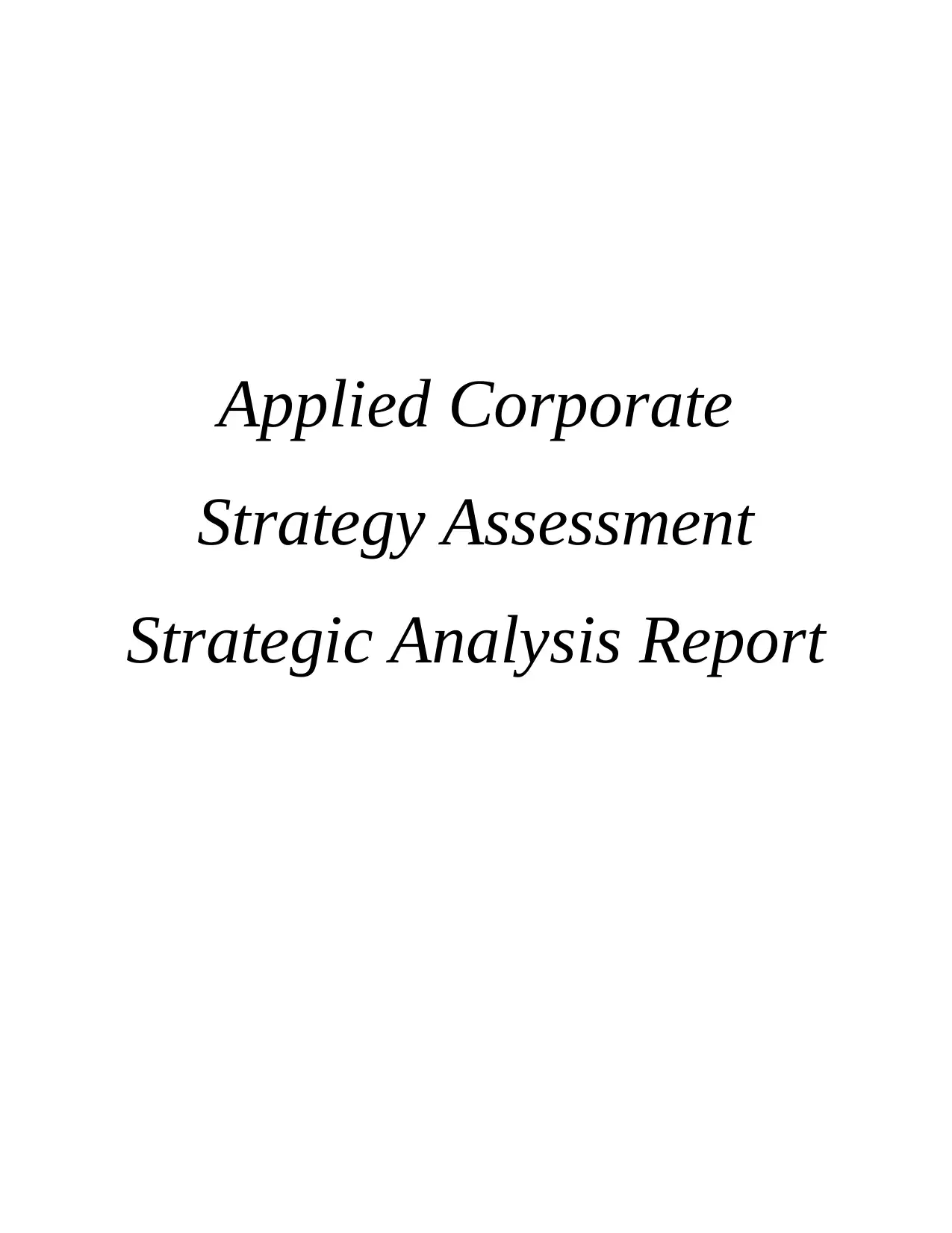
Applied Corporate
Strategy Assessment
Strategic Analysis Report
Strategy Assessment
Strategic Analysis Report
Paraphrase This Document
Need a fresh take? Get an instant paraphrase of this document with our AI Paraphraser
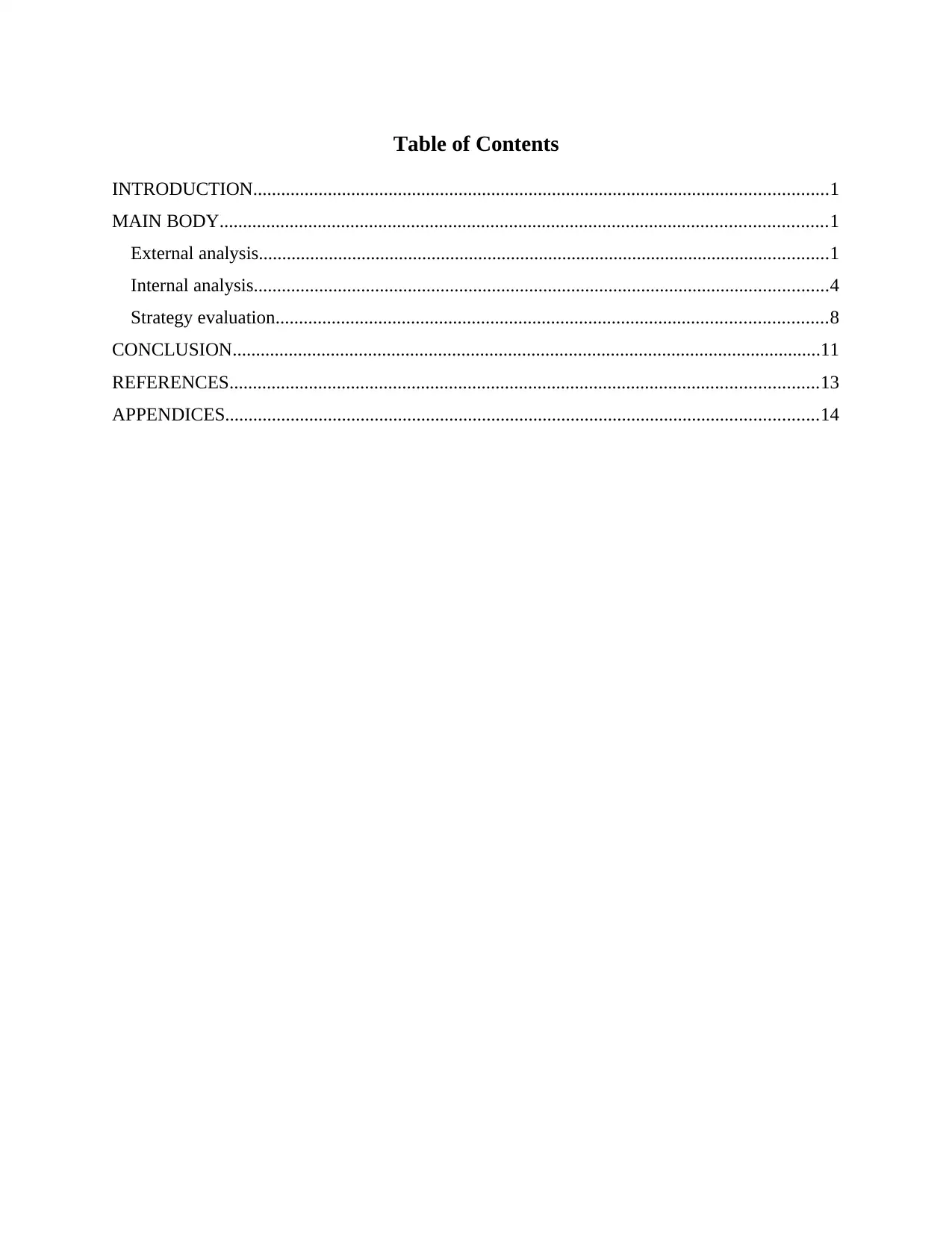
Table of Contents
INTRODUCTION...........................................................................................................................1
MAIN BODY..................................................................................................................................1
External analysis..........................................................................................................................1
Internal analysis...........................................................................................................................4
Strategy evaluation......................................................................................................................8
CONCLUSION..............................................................................................................................11
REFERENCES..............................................................................................................................13
APPENDICES...............................................................................................................................14
INTRODUCTION...........................................................................................................................1
MAIN BODY..................................................................................................................................1
External analysis..........................................................................................................................1
Internal analysis...........................................................................................................................4
Strategy evaluation......................................................................................................................8
CONCLUSION..............................................................................................................................11
REFERENCES..............................................................................................................................13
APPENDICES...............................................................................................................................14
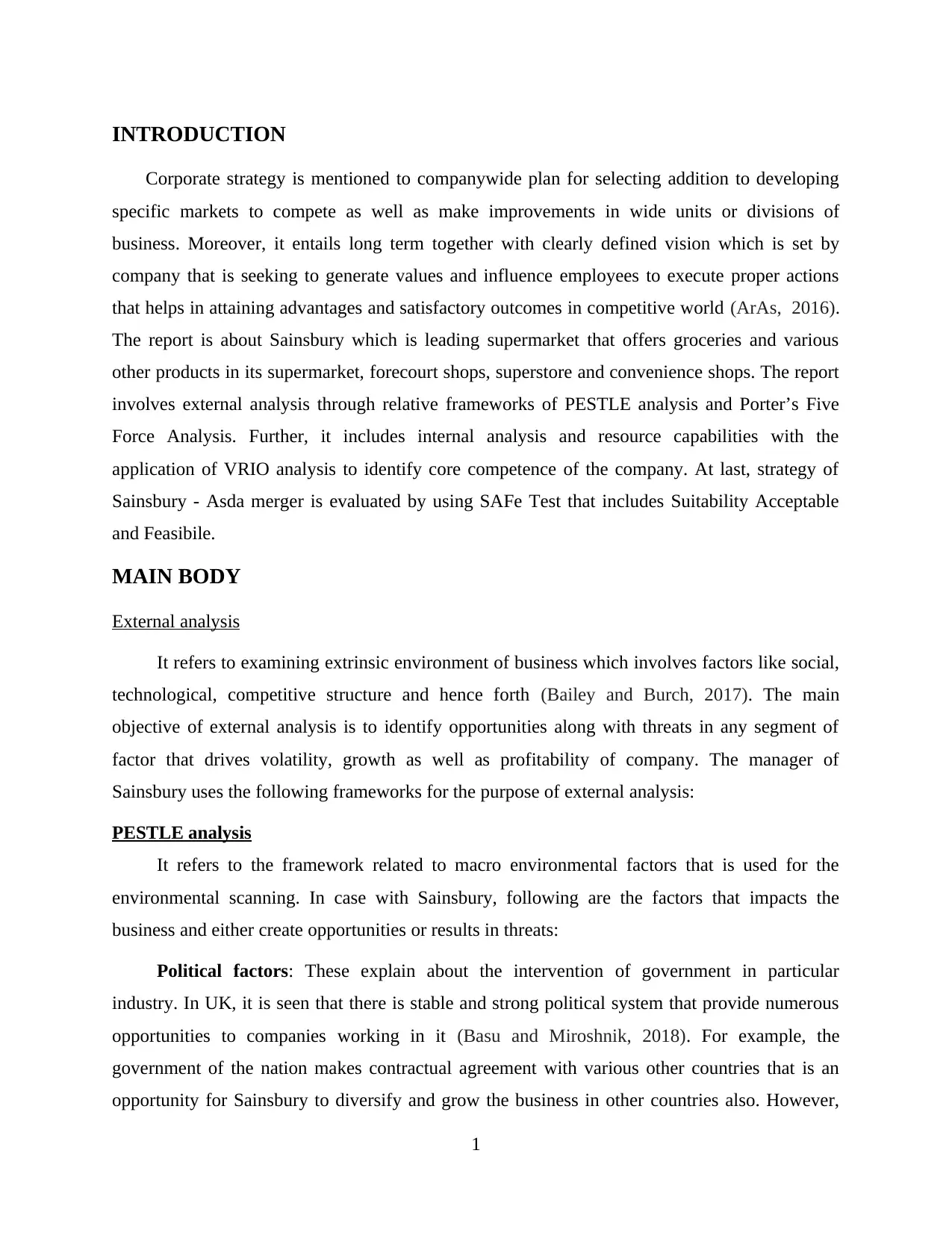
INTRODUCTION
Corporate strategy is mentioned to companywide plan for selecting addition to developing
specific markets to compete as well as make improvements in wide units or divisions of
business. Moreover, it entails long term together with clearly defined vision which is set by
company that is seeking to generate values and influence employees to execute proper actions
that helps in attaining advantages and satisfactory outcomes in competitive world (ArAs, 2016).
The report is about Sainsbury which is leading supermarket that offers groceries and various
other products in its supermarket, forecourt shops, superstore and convenience shops. The report
involves external analysis through relative frameworks of PESTLE analysis and Porter’s Five
Force Analysis. Further, it includes internal analysis and resource capabilities with the
application of VRIO analysis to identify core competence of the company. At last, strategy of
Sainsbury - Asda merger is evaluated by using SAFe Test that includes Suitability Acceptable
and Feasibile.
MAIN BODY
External analysis
It refers to examining extrinsic environment of business which involves factors like social,
technological, competitive structure and hence forth (Bailey and Burch, 2017). The main
objective of external analysis is to identify opportunities along with threats in any segment of
factor that drives volatility, growth as well as profitability of company. The manager of
Sainsbury uses the following frameworks for the purpose of external analysis:
PESTLE analysis
It refers to the framework related to macro environmental factors that is used for the
environmental scanning. In case with Sainsbury, following are the factors that impacts the
business and either create opportunities or results in threats:
Political factors: These explain about the intervention of government in particular
industry. In UK, it is seen that there is stable and strong political system that provide numerous
opportunities to companies working in it (Basu and Miroshnik, 2018). For example, the
government of the nation makes contractual agreement with various other countries that is an
opportunity for Sainsbury to diversify and grow the business in other countries also. However,
1
Corporate strategy is mentioned to companywide plan for selecting addition to developing
specific markets to compete as well as make improvements in wide units or divisions of
business. Moreover, it entails long term together with clearly defined vision which is set by
company that is seeking to generate values and influence employees to execute proper actions
that helps in attaining advantages and satisfactory outcomes in competitive world (ArAs, 2016).
The report is about Sainsbury which is leading supermarket that offers groceries and various
other products in its supermarket, forecourt shops, superstore and convenience shops. The report
involves external analysis through relative frameworks of PESTLE analysis and Porter’s Five
Force Analysis. Further, it includes internal analysis and resource capabilities with the
application of VRIO analysis to identify core competence of the company. At last, strategy of
Sainsbury - Asda merger is evaluated by using SAFe Test that includes Suitability Acceptable
and Feasibile.
MAIN BODY
External analysis
It refers to examining extrinsic environment of business which involves factors like social,
technological, competitive structure and hence forth (Bailey and Burch, 2017). The main
objective of external analysis is to identify opportunities along with threats in any segment of
factor that drives volatility, growth as well as profitability of company. The manager of
Sainsbury uses the following frameworks for the purpose of external analysis:
PESTLE analysis
It refers to the framework related to macro environmental factors that is used for the
environmental scanning. In case with Sainsbury, following are the factors that impacts the
business and either create opportunities or results in threats:
Political factors: These explain about the intervention of government in particular
industry. In UK, it is seen that there is stable and strong political system that provide numerous
opportunities to companies working in it (Basu and Miroshnik, 2018). For example, the
government of the nation makes contractual agreement with various other countries that is an
opportunity for Sainsbury to diversify and grow the business in other countries also. However,
1
⊘ This is a preview!⊘
Do you want full access?
Subscribe today to unlock all pages.

Trusted by 1+ million students worldwide
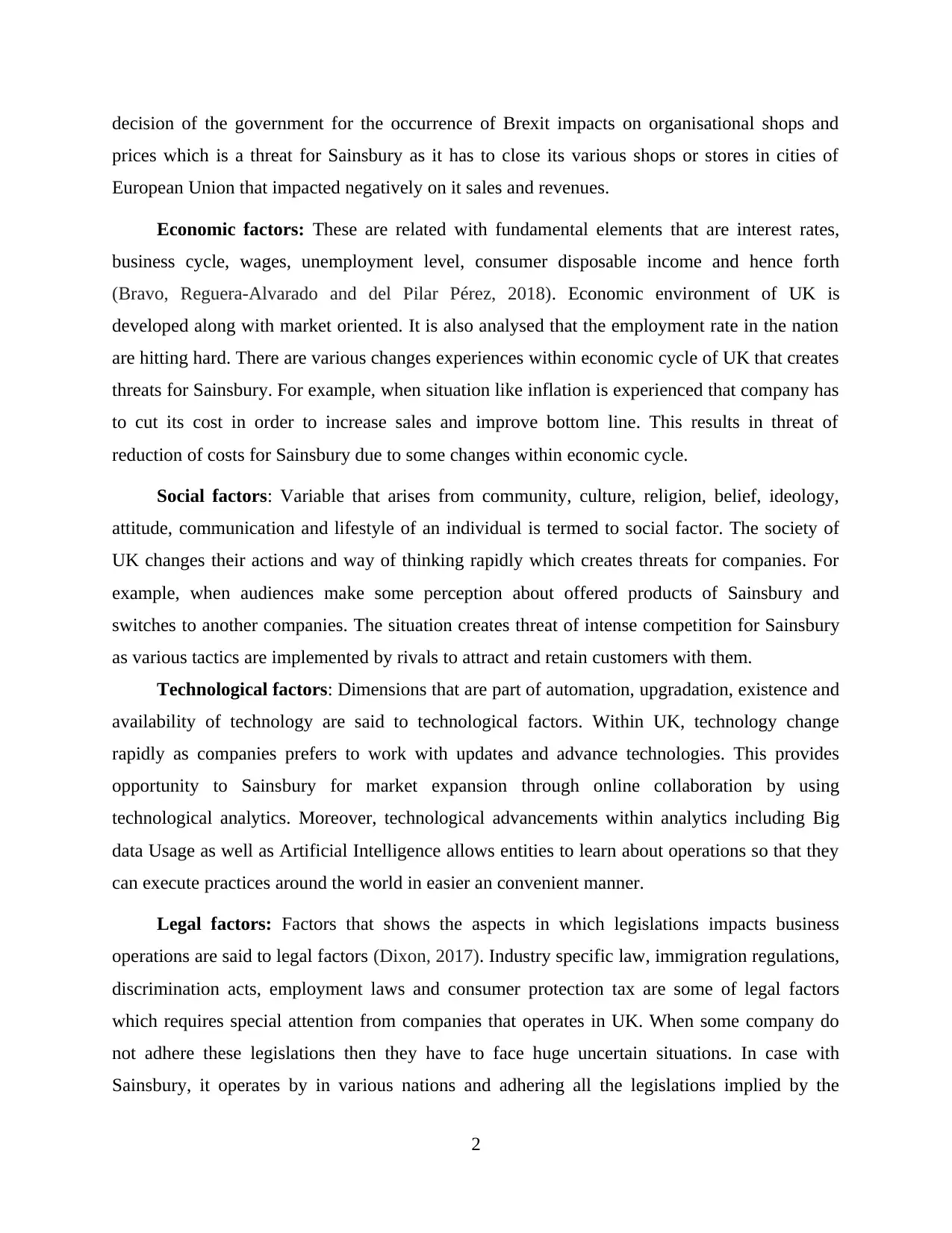
decision of the government for the occurrence of Brexit impacts on organisational shops and
prices which is a threat for Sainsbury as it has to close its various shops or stores in cities of
European Union that impacted negatively on it sales and revenues.
Economic factors: These are related with fundamental elements that are interest rates,
business cycle, wages, unemployment level, consumer disposable income and hence forth
(Bravo, Reguera-Alvarado and del Pilar Pérez, 2018). Economic environment of UK is
developed along with market oriented. It is also analysed that the employment rate in the nation
are hitting hard. There are various changes experiences within economic cycle of UK that creates
threats for Sainsbury. For example, when situation like inflation is experienced that company has
to cut its cost in order to increase sales and improve bottom line. This results in threat of
reduction of costs for Sainsbury due to some changes within economic cycle.
Social factors: Variable that arises from community, culture, religion, belief, ideology,
attitude, communication and lifestyle of an individual is termed to social factor. The society of
UK changes their actions and way of thinking rapidly which creates threats for companies. For
example, when audiences make some perception about offered products of Sainsbury and
switches to another companies. The situation creates threat of intense competition for Sainsbury
as various tactics are implemented by rivals to attract and retain customers with them.
Technological factors: Dimensions that are part of automation, upgradation, existence and
availability of technology are said to technological factors. Within UK, technology change
rapidly as companies prefers to work with updates and advance technologies. This provides
opportunity to Sainsbury for market expansion through online collaboration by using
technological analytics. Moreover, technological advancements within analytics including Big
data Usage as well as Artificial Intelligence allows entities to learn about operations so that they
can execute practices around the world in easier an convenient manner.
Legal factors: Factors that shows the aspects in which legislations impacts business
operations are said to legal factors (Dixon, 2017). Industry specific law, immigration regulations,
discrimination acts, employment laws and consumer protection tax are some of legal factors
which requires special attention from companies that operates in UK. When some company do
not adhere these legislations then they have to face huge uncertain situations. In case with
Sainsbury, it operates by in various nations and adhering all the legislations implied by the
2
prices which is a threat for Sainsbury as it has to close its various shops or stores in cities of
European Union that impacted negatively on it sales and revenues.
Economic factors: These are related with fundamental elements that are interest rates,
business cycle, wages, unemployment level, consumer disposable income and hence forth
(Bravo, Reguera-Alvarado and del Pilar Pérez, 2018). Economic environment of UK is
developed along with market oriented. It is also analysed that the employment rate in the nation
are hitting hard. There are various changes experiences within economic cycle of UK that creates
threats for Sainsbury. For example, when situation like inflation is experienced that company has
to cut its cost in order to increase sales and improve bottom line. This results in threat of
reduction of costs for Sainsbury due to some changes within economic cycle.
Social factors: Variable that arises from community, culture, religion, belief, ideology,
attitude, communication and lifestyle of an individual is termed to social factor. The society of
UK changes their actions and way of thinking rapidly which creates threats for companies. For
example, when audiences make some perception about offered products of Sainsbury and
switches to another companies. The situation creates threat of intense competition for Sainsbury
as various tactics are implemented by rivals to attract and retain customers with them.
Technological factors: Dimensions that are part of automation, upgradation, existence and
availability of technology are said to technological factors. Within UK, technology change
rapidly as companies prefers to work with updates and advance technologies. This provides
opportunity to Sainsbury for market expansion through online collaboration by using
technological analytics. Moreover, technological advancements within analytics including Big
data Usage as well as Artificial Intelligence allows entities to learn about operations so that they
can execute practices around the world in easier an convenient manner.
Legal factors: Factors that shows the aspects in which legislations impacts business
operations are said to legal factors (Dixon, 2017). Industry specific law, immigration regulations,
discrimination acts, employment laws and consumer protection tax are some of legal factors
which requires special attention from companies that operates in UK. When some company do
not adhere these legislations then they have to face huge uncertain situations. In case with
Sainsbury, it operates by in various nations and adhering all the legislations implied by the
2
Paraphrase This Document
Need a fresh take? Get an instant paraphrase of this document with our AI Paraphraser
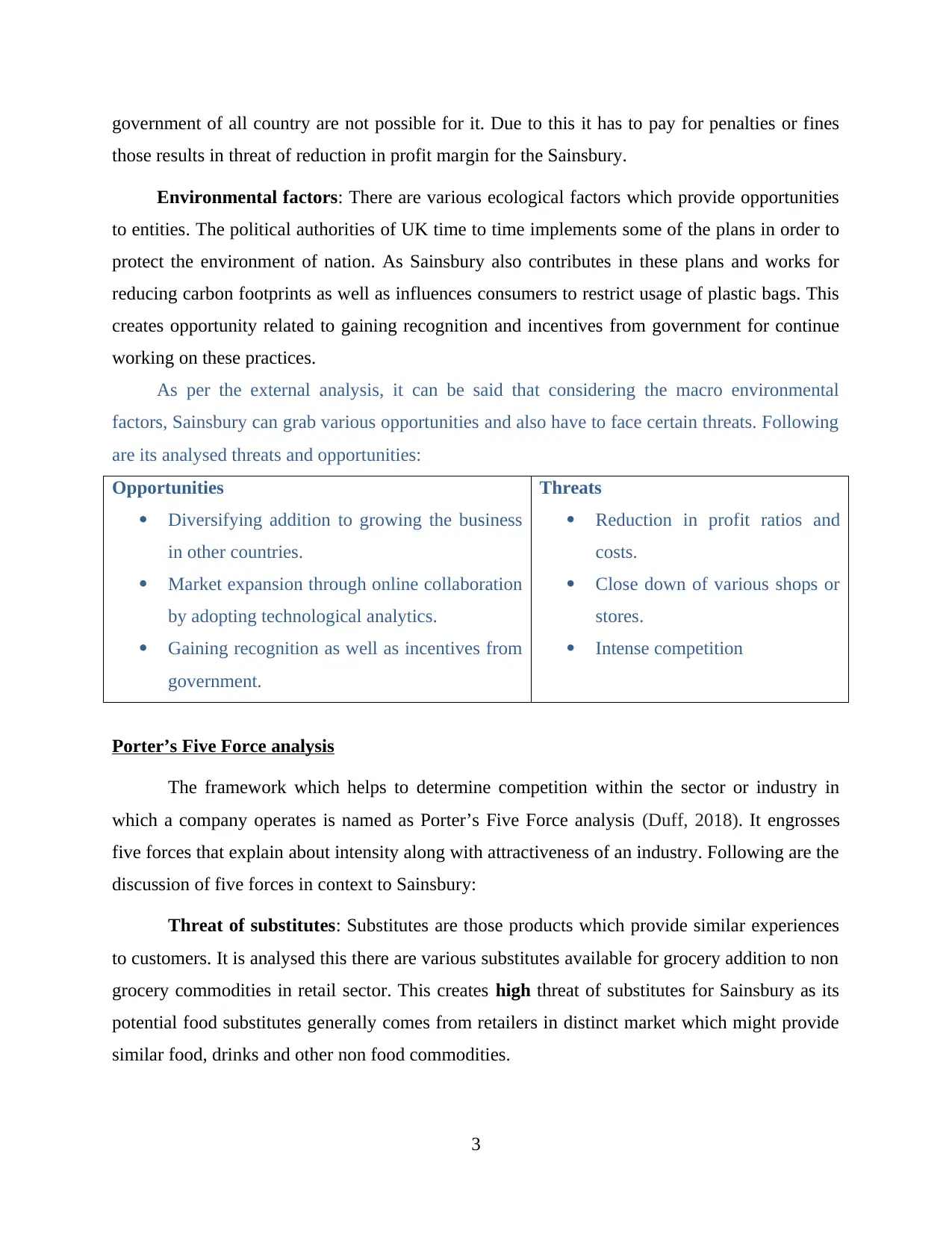
government of all country are not possible for it. Due to this it has to pay for penalties or fines
those results in threat of reduction in profit margin for the Sainsbury.
Environmental factors: There are various ecological factors which provide opportunities
to entities. The political authorities of UK time to time implements some of the plans in order to
protect the environment of nation. As Sainsbury also contributes in these plans and works for
reducing carbon footprints as well as influences consumers to restrict usage of plastic bags. This
creates opportunity related to gaining recognition and incentives from government for continue
working on these practices.
As per the external analysis, it can be said that considering the macro environmental
factors, Sainsbury can grab various opportunities and also have to face certain threats. Following
are its analysed threats and opportunities:
Opportunities
Diversifying addition to growing the business
in other countries.
Market expansion through online collaboration
by adopting technological analytics.
Gaining recognition as well as incentives from
government.
Threats
Reduction in profit ratios and
costs.
Close down of various shops or
stores.
Intense competition
Porter’s Five Force analysis
The framework which helps to determine competition within the sector or industry in
which a company operates is named as Porter’s Five Force analysis (Duff, 2018). It engrosses
five forces that explain about intensity along with attractiveness of an industry. Following are the
discussion of five forces in context to Sainsbury:
Threat of substitutes: Substitutes are those products which provide similar experiences
to customers. It is analysed this there are various substitutes available for grocery addition to non
grocery commodities in retail sector. This creates high threat of substitutes for Sainsbury as its
potential food substitutes generally comes from retailers in distinct market which might provide
similar food, drinks and other non food commodities.
3
those results in threat of reduction in profit margin for the Sainsbury.
Environmental factors: There are various ecological factors which provide opportunities
to entities. The political authorities of UK time to time implements some of the plans in order to
protect the environment of nation. As Sainsbury also contributes in these plans and works for
reducing carbon footprints as well as influences consumers to restrict usage of plastic bags. This
creates opportunity related to gaining recognition and incentives from government for continue
working on these practices.
As per the external analysis, it can be said that considering the macro environmental
factors, Sainsbury can grab various opportunities and also have to face certain threats. Following
are its analysed threats and opportunities:
Opportunities
Diversifying addition to growing the business
in other countries.
Market expansion through online collaboration
by adopting technological analytics.
Gaining recognition as well as incentives from
government.
Threats
Reduction in profit ratios and
costs.
Close down of various shops or
stores.
Intense competition
Porter’s Five Force analysis
The framework which helps to determine competition within the sector or industry in
which a company operates is named as Porter’s Five Force analysis (Duff, 2018). It engrosses
five forces that explain about intensity along with attractiveness of an industry. Following are the
discussion of five forces in context to Sainsbury:
Threat of substitutes: Substitutes are those products which provide similar experiences
to customers. It is analysed this there are various substitutes available for grocery addition to non
grocery commodities in retail sector. This creates high threat of substitutes for Sainsbury as its
potential food substitutes generally comes from retailers in distinct market which might provide
similar food, drinks and other non food commodities.
3
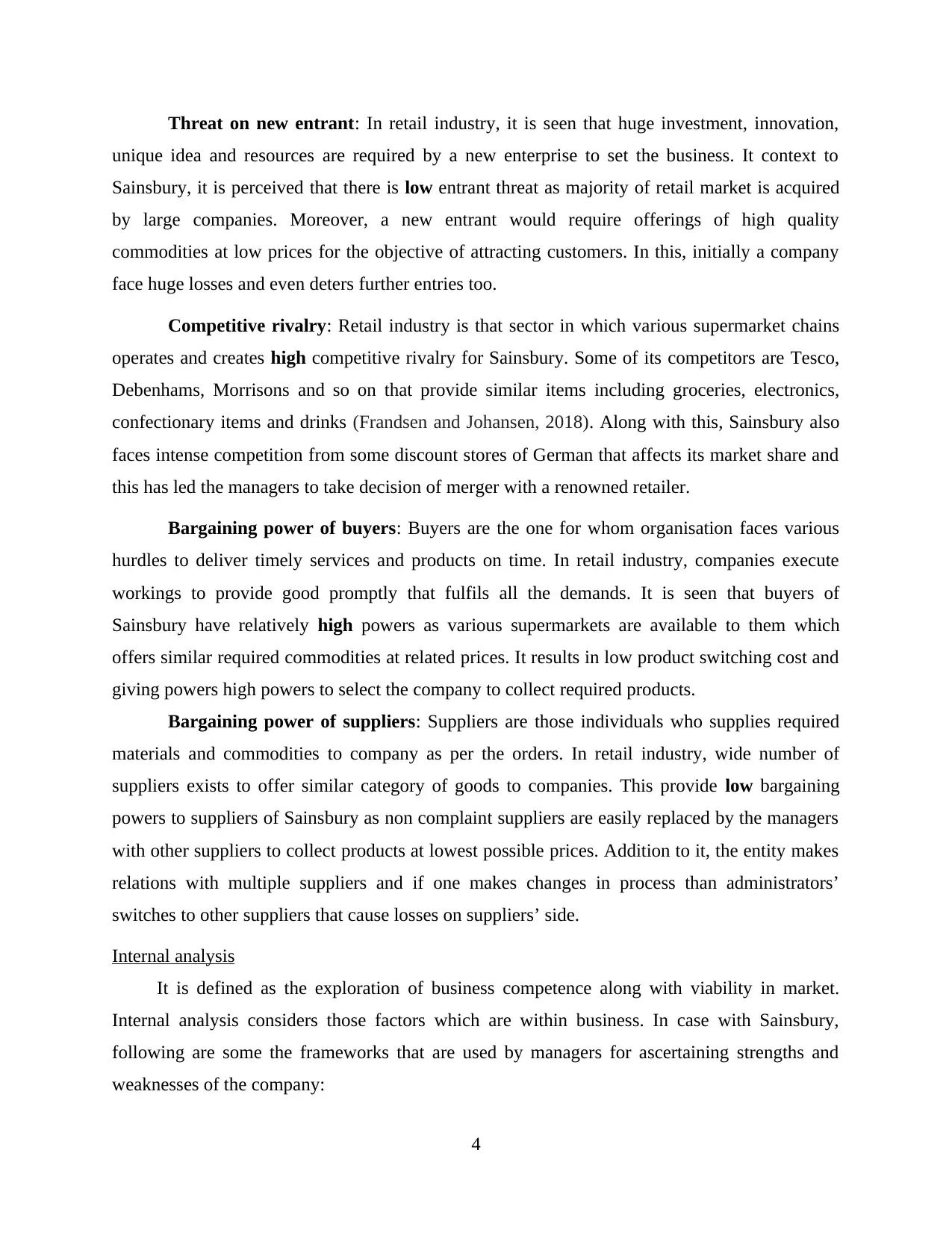
Threat on new entrant: In retail industry, it is seen that huge investment, innovation,
unique idea and resources are required by a new enterprise to set the business. It context to
Sainsbury, it is perceived that there is low entrant threat as majority of retail market is acquired
by large companies. Moreover, a new entrant would require offerings of high quality
commodities at low prices for the objective of attracting customers. In this, initially a company
face huge losses and even deters further entries too.
Competitive rivalry: Retail industry is that sector in which various supermarket chains
operates and creates high competitive rivalry for Sainsbury. Some of its competitors are Tesco,
Debenhams, Morrisons and so on that provide similar items including groceries, electronics,
confectionary items and drinks (Frandsen and Johansen, 2018). Along with this, Sainsbury also
faces intense competition from some discount stores of German that affects its market share and
this has led the managers to take decision of merger with a renowned retailer.
Bargaining power of buyers: Buyers are the one for whom organisation faces various
hurdles to deliver timely services and products on time. In retail industry, companies execute
workings to provide good promptly that fulfils all the demands. It is seen that buyers of
Sainsbury have relatively high powers as various supermarkets are available to them which
offers similar required commodities at related prices. It results in low product switching cost and
giving powers high powers to select the company to collect required products.
Bargaining power of suppliers: Suppliers are those individuals who supplies required
materials and commodities to company as per the orders. In retail industry, wide number of
suppliers exists to offer similar category of goods to companies. This provide low bargaining
powers to suppliers of Sainsbury as non complaint suppliers are easily replaced by the managers
with other suppliers to collect products at lowest possible prices. Addition to it, the entity makes
relations with multiple suppliers and if one makes changes in process than administrators’
switches to other suppliers that cause losses on suppliers’ side.
Internal analysis
It is defined as the exploration of business competence along with viability in market.
Internal analysis considers those factors which are within business. In case with Sainsbury,
following are some the frameworks that are used by managers for ascertaining strengths and
weaknesses of the company:
4
unique idea and resources are required by a new enterprise to set the business. It context to
Sainsbury, it is perceived that there is low entrant threat as majority of retail market is acquired
by large companies. Moreover, a new entrant would require offerings of high quality
commodities at low prices for the objective of attracting customers. In this, initially a company
face huge losses and even deters further entries too.
Competitive rivalry: Retail industry is that sector in which various supermarket chains
operates and creates high competitive rivalry for Sainsbury. Some of its competitors are Tesco,
Debenhams, Morrisons and so on that provide similar items including groceries, electronics,
confectionary items and drinks (Frandsen and Johansen, 2018). Along with this, Sainsbury also
faces intense competition from some discount stores of German that affects its market share and
this has led the managers to take decision of merger with a renowned retailer.
Bargaining power of buyers: Buyers are the one for whom organisation faces various
hurdles to deliver timely services and products on time. In retail industry, companies execute
workings to provide good promptly that fulfils all the demands. It is seen that buyers of
Sainsbury have relatively high powers as various supermarkets are available to them which
offers similar required commodities at related prices. It results in low product switching cost and
giving powers high powers to select the company to collect required products.
Bargaining power of suppliers: Suppliers are those individuals who supplies required
materials and commodities to company as per the orders. In retail industry, wide number of
suppliers exists to offer similar category of goods to companies. This provide low bargaining
powers to suppliers of Sainsbury as non complaint suppliers are easily replaced by the managers
with other suppliers to collect products at lowest possible prices. Addition to it, the entity makes
relations with multiple suppliers and if one makes changes in process than administrators’
switches to other suppliers that cause losses on suppliers’ side.
Internal analysis
It is defined as the exploration of business competence along with viability in market.
Internal analysis considers those factors which are within business. In case with Sainsbury,
following are some the frameworks that are used by managers for ascertaining strengths and
weaknesses of the company:
4
⊘ This is a preview!⊘
Do you want full access?
Subscribe today to unlock all pages.

Trusted by 1+ million students worldwide
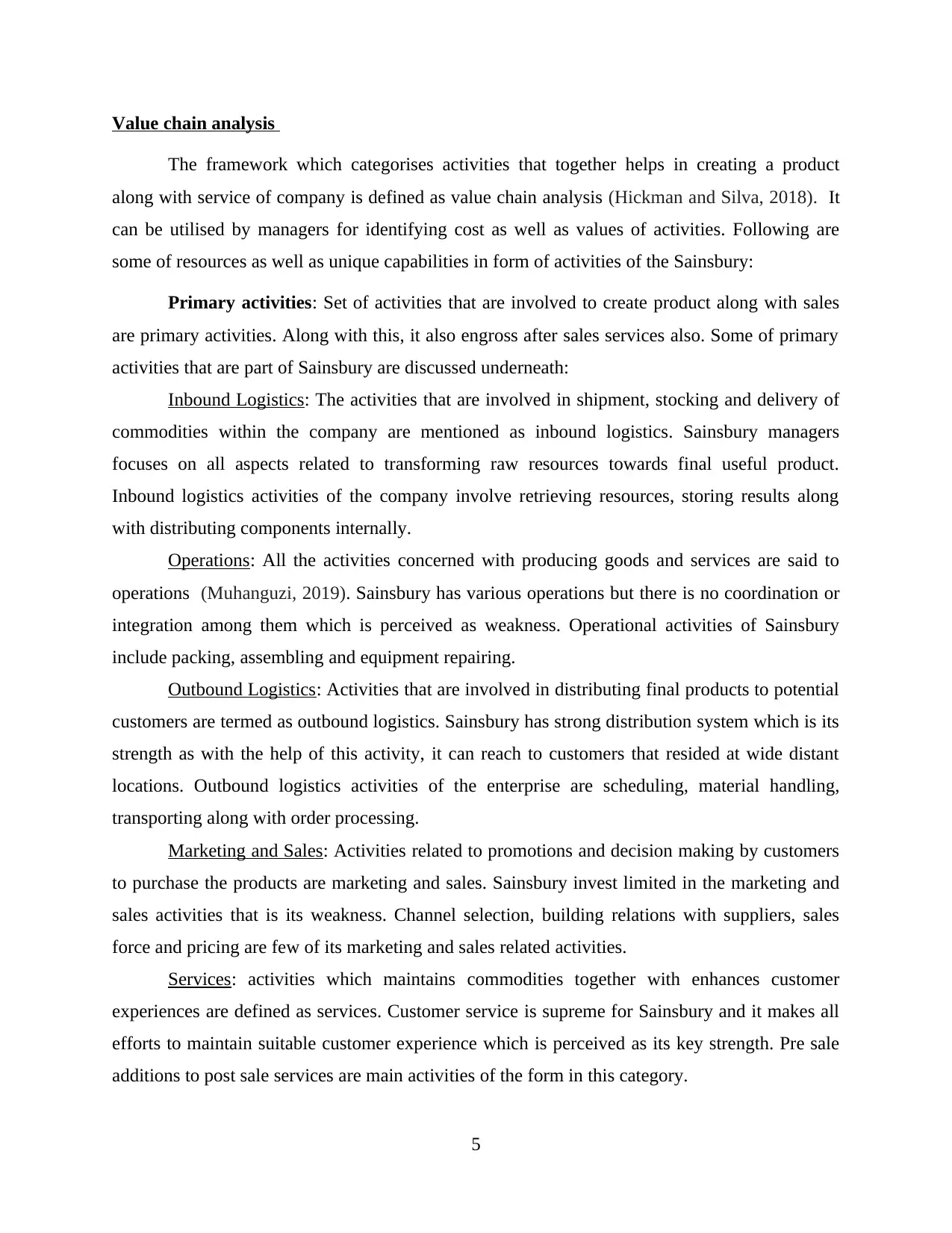
Value chain analysis
The framework which categorises activities that together helps in creating a product
along with service of company is defined as value chain analysis (Hickman and Silva, 2018). It
can be utilised by managers for identifying cost as well as values of activities. Following are
some of resources as well as unique capabilities in form of activities of the Sainsbury:
Primary activities: Set of activities that are involved to create product along with sales
are primary activities. Along with this, it also engross after sales services also. Some of primary
activities that are part of Sainsbury are discussed underneath:
Inbound Logistics: The activities that are involved in shipment, stocking and delivery of
commodities within the company are mentioned as inbound logistics. Sainsbury managers
focuses on all aspects related to transforming raw resources towards final useful product.
Inbound logistics activities of the company involve retrieving resources, storing results along
with distributing components internally.
Operations: All the activities concerned with producing goods and services are said to
operations (Muhanguzi, 2019). Sainsbury has various operations but there is no coordination or
integration among them which is perceived as weakness. Operational activities of Sainsbury
include packing, assembling and equipment repairing.
Outbound Logistics: Activities that are involved in distributing final products to potential
customers are termed as outbound logistics. Sainsbury has strong distribution system which is its
strength as with the help of this activity, it can reach to customers that resided at wide distant
locations. Outbound logistics activities of the enterprise are scheduling, material handling,
transporting along with order processing.
Marketing and Sales: Activities related to promotions and decision making by customers
to purchase the products are marketing and sales. Sainsbury invest limited in the marketing and
sales activities that is its weakness. Channel selection, building relations with suppliers, sales
force and pricing are few of its marketing and sales related activities.
Services: activities which maintains commodities together with enhances customer
experiences are defined as services. Customer service is supreme for Sainsbury and it makes all
efforts to maintain suitable customer experience which is perceived as its key strength. Pre sale
additions to post sale services are main activities of the form in this category.
5
The framework which categorises activities that together helps in creating a product
along with service of company is defined as value chain analysis (Hickman and Silva, 2018). It
can be utilised by managers for identifying cost as well as values of activities. Following are
some of resources as well as unique capabilities in form of activities of the Sainsbury:
Primary activities: Set of activities that are involved to create product along with sales
are primary activities. Along with this, it also engross after sales services also. Some of primary
activities that are part of Sainsbury are discussed underneath:
Inbound Logistics: The activities that are involved in shipment, stocking and delivery of
commodities within the company are mentioned as inbound logistics. Sainsbury managers
focuses on all aspects related to transforming raw resources towards final useful product.
Inbound logistics activities of the company involve retrieving resources, storing results along
with distributing components internally.
Operations: All the activities concerned with producing goods and services are said to
operations (Muhanguzi, 2019). Sainsbury has various operations but there is no coordination or
integration among them which is perceived as weakness. Operational activities of Sainsbury
include packing, assembling and equipment repairing.
Outbound Logistics: Activities that are involved in distributing final products to potential
customers are termed as outbound logistics. Sainsbury has strong distribution system which is its
strength as with the help of this activity, it can reach to customers that resided at wide distant
locations. Outbound logistics activities of the enterprise are scheduling, material handling,
transporting along with order processing.
Marketing and Sales: Activities related to promotions and decision making by customers
to purchase the products are marketing and sales. Sainsbury invest limited in the marketing and
sales activities that is its weakness. Channel selection, building relations with suppliers, sales
force and pricing are few of its marketing and sales related activities.
Services: activities which maintains commodities together with enhances customer
experiences are defined as services. Customer service is supreme for Sainsbury and it makes all
efforts to maintain suitable customer experience which is perceived as its key strength. Pre sale
additions to post sale services are main activities of the form in this category.
5
Paraphrase This Document
Need a fresh take? Get an instant paraphrase of this document with our AI Paraphraser
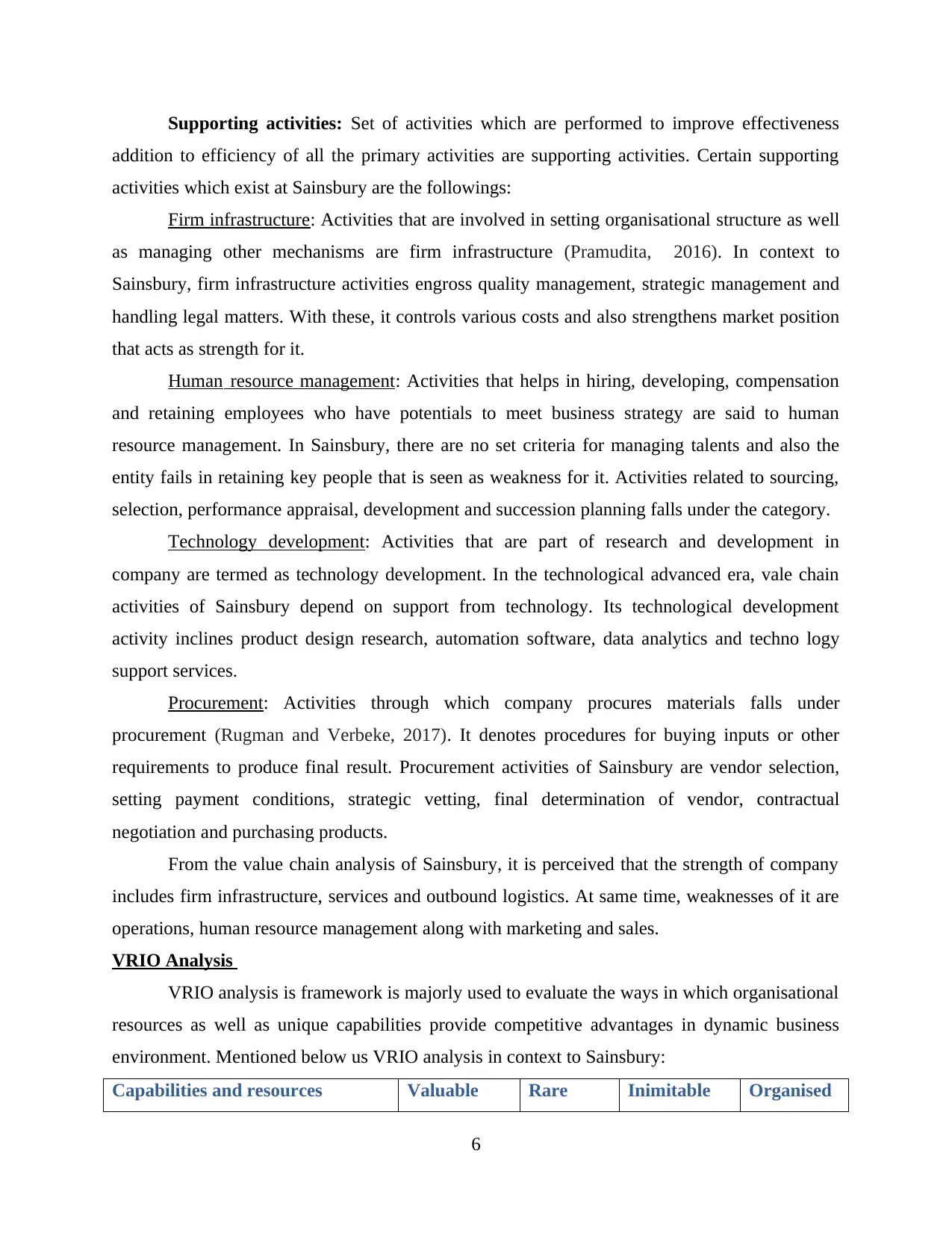
Supporting activities: Set of activities which are performed to improve effectiveness
addition to efficiency of all the primary activities are supporting activities. Certain supporting
activities which exist at Sainsbury are the followings:
Firm infrastructure: Activities that are involved in setting organisational structure as well
as managing other mechanisms are firm infrastructure (Pramudita, 2016). In context to
Sainsbury, firm infrastructure activities engross quality management, strategic management and
handling legal matters. With these, it controls various costs and also strengthens market position
that acts as strength for it.
Human resource management: Activities that helps in hiring, developing, compensation
and retaining employees who have potentials to meet business strategy are said to human
resource management. In Sainsbury, there are no set criteria for managing talents and also the
entity fails in retaining key people that is seen as weakness for it. Activities related to sourcing,
selection, performance appraisal, development and succession planning falls under the category.
Technology development: Activities that are part of research and development in
company are termed as technology development. In the technological advanced era, vale chain
activities of Sainsbury depend on support from technology. Its technological development
activity inclines product design research, automation software, data analytics and techno logy
support services.
Procurement: Activities through which company procures materials falls under
procurement (Rugman and Verbeke, 2017). It denotes procedures for buying inputs or other
requirements to produce final result. Procurement activities of Sainsbury are vendor selection,
setting payment conditions, strategic vetting, final determination of vendor, contractual
negotiation and purchasing products.
From the value chain analysis of Sainsbury, it is perceived that the strength of company
includes firm infrastructure, services and outbound logistics. At same time, weaknesses of it are
operations, human resource management along with marketing and sales.
VRIO Analysis
VRIO analysis is framework is majorly used to evaluate the ways in which organisational
resources as well as unique capabilities provide competitive advantages in dynamic business
environment. Mentioned below us VRIO analysis in context to Sainsbury:
Capabilities and resources Valuable Rare Inimitable Organised
6
addition to efficiency of all the primary activities are supporting activities. Certain supporting
activities which exist at Sainsbury are the followings:
Firm infrastructure: Activities that are involved in setting organisational structure as well
as managing other mechanisms are firm infrastructure (Pramudita, 2016). In context to
Sainsbury, firm infrastructure activities engross quality management, strategic management and
handling legal matters. With these, it controls various costs and also strengthens market position
that acts as strength for it.
Human resource management: Activities that helps in hiring, developing, compensation
and retaining employees who have potentials to meet business strategy are said to human
resource management. In Sainsbury, there are no set criteria for managing talents and also the
entity fails in retaining key people that is seen as weakness for it. Activities related to sourcing,
selection, performance appraisal, development and succession planning falls under the category.
Technology development: Activities that are part of research and development in
company are termed as technology development. In the technological advanced era, vale chain
activities of Sainsbury depend on support from technology. Its technological development
activity inclines product design research, automation software, data analytics and techno logy
support services.
Procurement: Activities through which company procures materials falls under
procurement (Rugman and Verbeke, 2017). It denotes procedures for buying inputs or other
requirements to produce final result. Procurement activities of Sainsbury are vendor selection,
setting payment conditions, strategic vetting, final determination of vendor, contractual
negotiation and purchasing products.
From the value chain analysis of Sainsbury, it is perceived that the strength of company
includes firm infrastructure, services and outbound logistics. At same time, weaknesses of it are
operations, human resource management along with marketing and sales.
VRIO Analysis
VRIO analysis is framework is majorly used to evaluate the ways in which organisational
resources as well as unique capabilities provide competitive advantages in dynamic business
environment. Mentioned below us VRIO analysis in context to Sainsbury:
Capabilities and resources Valuable Rare Inimitable Organised
6
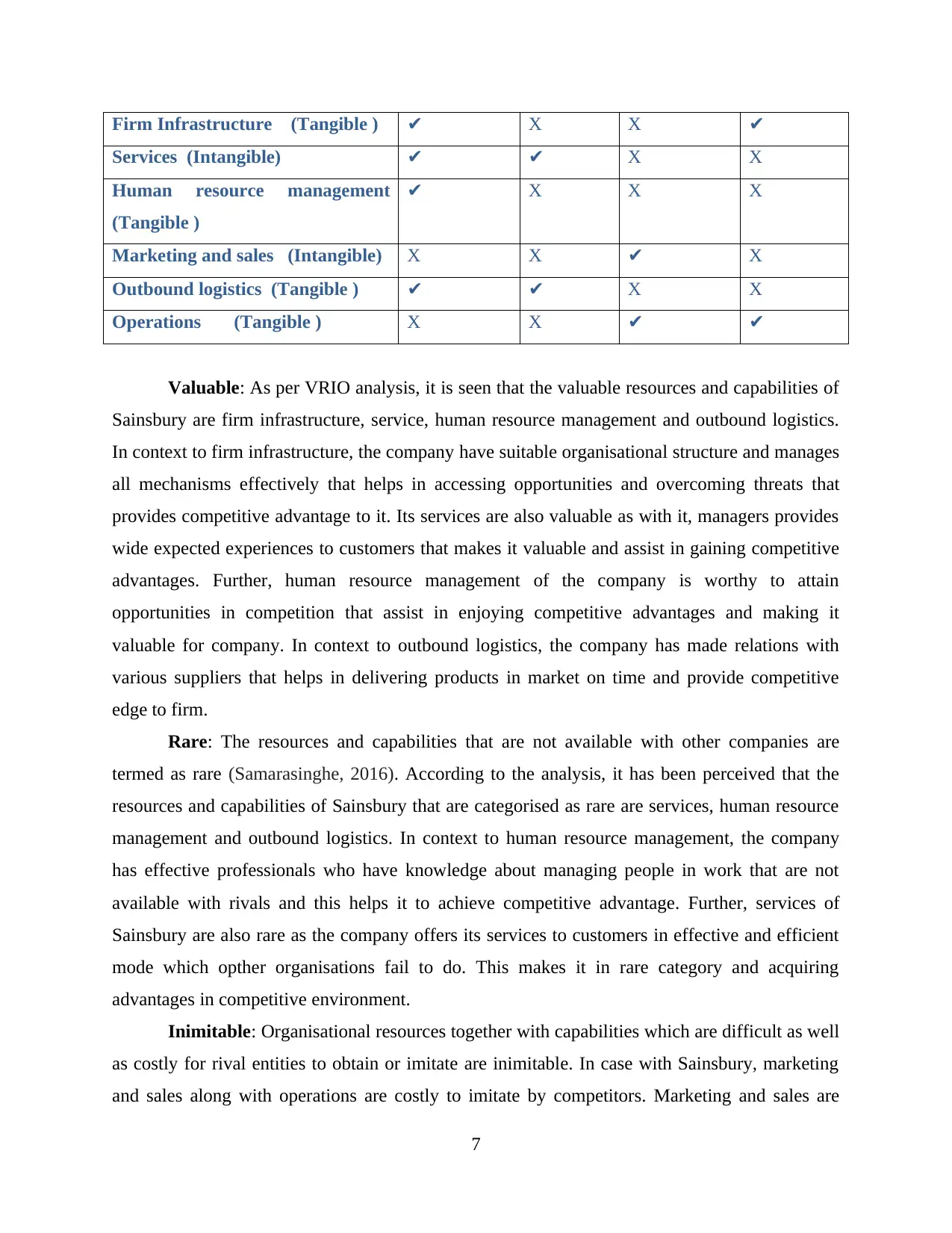
Firm Infrastructure (Tangible ) ✔ X X ✔
Services (Intangible) ✔ ✔ X X
Human resource management
(Tangible )
✔ X X X
Marketing and sales (Intangible) X X ✔ X
Outbound logistics (Tangible ) ✔ ✔ X X
Operations (Tangible ) X X ✔ ✔
Valuable: As per VRIO analysis, it is seen that the valuable resources and capabilities of
Sainsbury are firm infrastructure, service, human resource management and outbound logistics.
In context to firm infrastructure, the company have suitable organisational structure and manages
all mechanisms effectively that helps in accessing opportunities and overcoming threats that
provides competitive advantage to it. Its services are also valuable as with it, managers provides
wide expected experiences to customers that makes it valuable and assist in gaining competitive
advantages. Further, human resource management of the company is worthy to attain
opportunities in competition that assist in enjoying competitive advantages and making it
valuable for company. In context to outbound logistics, the company has made relations with
various suppliers that helps in delivering products in market on time and provide competitive
edge to firm.
Rare: The resources and capabilities that are not available with other companies are
termed as rare (Samarasinghe, 2016). According to the analysis, it has been perceived that the
resources and capabilities of Sainsbury that are categorised as rare are services, human resource
management and outbound logistics. In context to human resource management, the company
has effective professionals who have knowledge about managing people in work that are not
available with rivals and this helps it to achieve competitive advantage. Further, services of
Sainsbury are also rare as the company offers its services to customers in effective and efficient
mode which opther organisations fail to do. This makes it in rare category and acquiring
advantages in competitive environment.
Inimitable: Organisational resources together with capabilities which are difficult as well
as costly for rival entities to obtain or imitate are inimitable. In case with Sainsbury, marketing
and sales along with operations are costly to imitate by competitors. Marketing and sales are
7
Services (Intangible) ✔ ✔ X X
Human resource management
(Tangible )
✔ X X X
Marketing and sales (Intangible) X X ✔ X
Outbound logistics (Tangible ) ✔ ✔ X X
Operations (Tangible ) X X ✔ ✔
Valuable: As per VRIO analysis, it is seen that the valuable resources and capabilities of
Sainsbury are firm infrastructure, service, human resource management and outbound logistics.
In context to firm infrastructure, the company have suitable organisational structure and manages
all mechanisms effectively that helps in accessing opportunities and overcoming threats that
provides competitive advantage to it. Its services are also valuable as with it, managers provides
wide expected experiences to customers that makes it valuable and assist in gaining competitive
advantages. Further, human resource management of the company is worthy to attain
opportunities in competition that assist in enjoying competitive advantages and making it
valuable for company. In context to outbound logistics, the company has made relations with
various suppliers that helps in delivering products in market on time and provide competitive
edge to firm.
Rare: The resources and capabilities that are not available with other companies are
termed as rare (Samarasinghe, 2016). According to the analysis, it has been perceived that the
resources and capabilities of Sainsbury that are categorised as rare are services, human resource
management and outbound logistics. In context to human resource management, the company
has effective professionals who have knowledge about managing people in work that are not
available with rivals and this helps it to achieve competitive advantage. Further, services of
Sainsbury are also rare as the company offers its services to customers in effective and efficient
mode which opther organisations fail to do. This makes it in rare category and acquiring
advantages in competitive environment.
Inimitable: Organisational resources together with capabilities which are difficult as well
as costly for rival entities to obtain or imitate are inimitable. In case with Sainsbury, marketing
and sales along with operations are costly to imitate by competitors. Marketing and sales are
7
⊘ This is a preview!⊘
Do you want full access?
Subscribe today to unlock all pages.

Trusted by 1+ million students worldwide
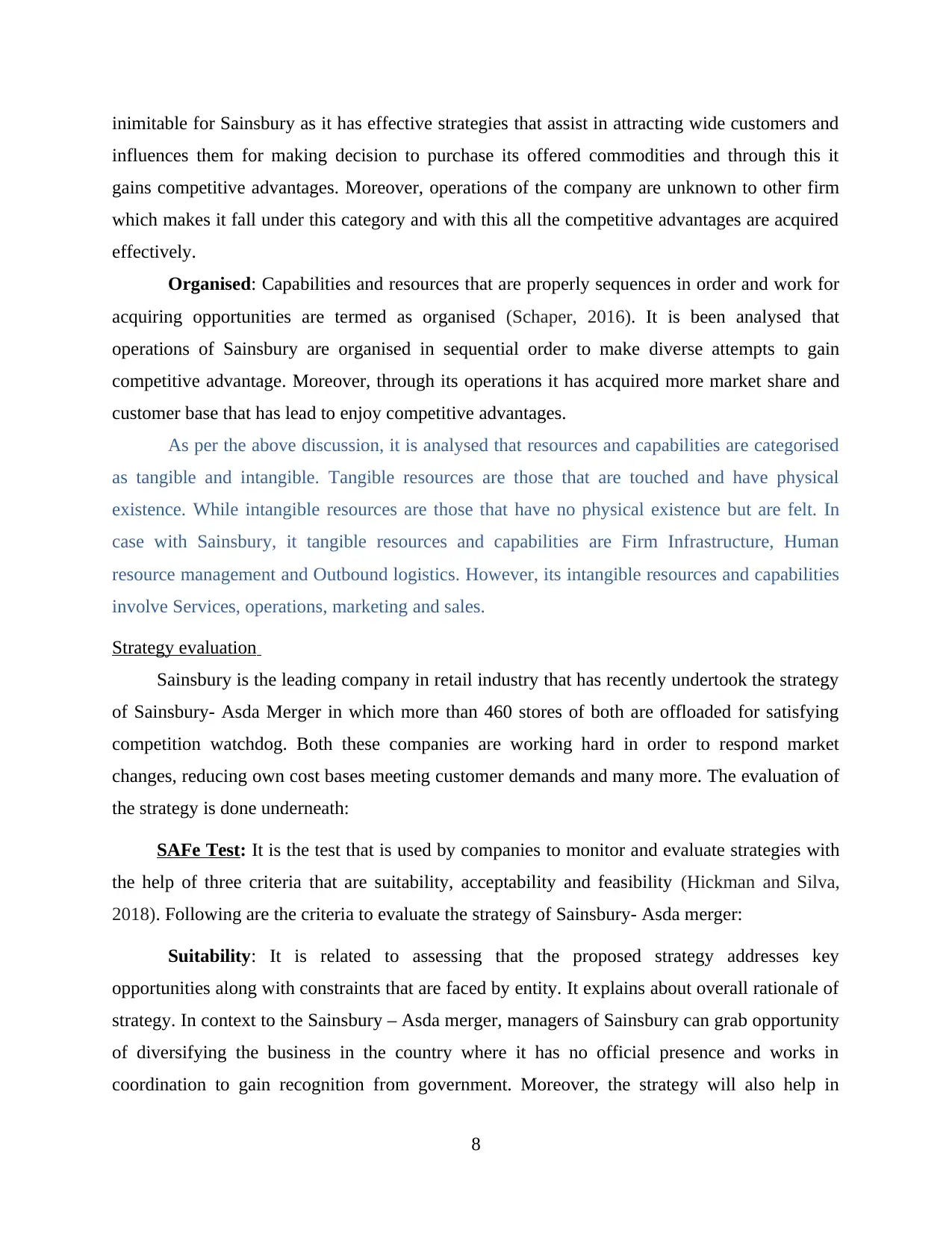
inimitable for Sainsbury as it has effective strategies that assist in attracting wide customers and
influences them for making decision to purchase its offered commodities and through this it
gains competitive advantages. Moreover, operations of the company are unknown to other firm
which makes it fall under this category and with this all the competitive advantages are acquired
effectively.
Organised: Capabilities and resources that are properly sequences in order and work for
acquiring opportunities are termed as organised (Schaper, 2016). It is been analysed that
operations of Sainsbury are organised in sequential order to make diverse attempts to gain
competitive advantage. Moreover, through its operations it has acquired more market share and
customer base that has lead to enjoy competitive advantages.
As per the above discussion, it is analysed that resources and capabilities are categorised
as tangible and intangible. Tangible resources are those that are touched and have physical
existence. While intangible resources are those that have no physical existence but are felt. In
case with Sainsbury, it tangible resources and capabilities are Firm Infrastructure, Human
resource management and Outbound logistics. However, its intangible resources and capabilities
involve Services, operations, marketing and sales.
Strategy evaluation
Sainsbury is the leading company in retail industry that has recently undertook the strategy
of Sainsbury- Asda Merger in which more than 460 stores of both are offloaded for satisfying
competition watchdog. Both these companies are working hard in order to respond market
changes, reducing own cost bases meeting customer demands and many more. The evaluation of
the strategy is done underneath:
SAFe Test: It is the test that is used by companies to monitor and evaluate strategies with
the help of three criteria that are suitability, acceptability and feasibility (Hickman and Silva,
2018). Following are the criteria to evaluate the strategy of Sainsbury- Asda merger:
Suitability: It is related to assessing that the proposed strategy addresses key
opportunities along with constraints that are faced by entity. It explains about overall rationale of
strategy. In context to the Sainsbury – Asda merger, managers of Sainsbury can grab opportunity
of diversifying the business in the country where it has no official presence and works in
coordination to gain recognition from government. Moreover, the strategy will also help in
8
influences them for making decision to purchase its offered commodities and through this it
gains competitive advantages. Moreover, operations of the company are unknown to other firm
which makes it fall under this category and with this all the competitive advantages are acquired
effectively.
Organised: Capabilities and resources that are properly sequences in order and work for
acquiring opportunities are termed as organised (Schaper, 2016). It is been analysed that
operations of Sainsbury are organised in sequential order to make diverse attempts to gain
competitive advantage. Moreover, through its operations it has acquired more market share and
customer base that has lead to enjoy competitive advantages.
As per the above discussion, it is analysed that resources and capabilities are categorised
as tangible and intangible. Tangible resources are those that are touched and have physical
existence. While intangible resources are those that have no physical existence but are felt. In
case with Sainsbury, it tangible resources and capabilities are Firm Infrastructure, Human
resource management and Outbound logistics. However, its intangible resources and capabilities
involve Services, operations, marketing and sales.
Strategy evaluation
Sainsbury is the leading company in retail industry that has recently undertook the strategy
of Sainsbury- Asda Merger in which more than 460 stores of both are offloaded for satisfying
competition watchdog. Both these companies are working hard in order to respond market
changes, reducing own cost bases meeting customer demands and many more. The evaluation of
the strategy is done underneath:
SAFe Test: It is the test that is used by companies to monitor and evaluate strategies with
the help of three criteria that are suitability, acceptability and feasibility (Hickman and Silva,
2018). Following are the criteria to evaluate the strategy of Sainsbury- Asda merger:
Suitability: It is related to assessing that the proposed strategy addresses key
opportunities along with constraints that are faced by entity. It explains about overall rationale of
strategy. In context to the Sainsbury – Asda merger, managers of Sainsbury can grab opportunity
of diversifying the business in the country where it has no official presence and works in
coordination to gain recognition from government. Moreover, the strategy will also help in
8
Paraphrase This Document
Need a fresh take? Get an instant paraphrase of this document with our AI Paraphraser
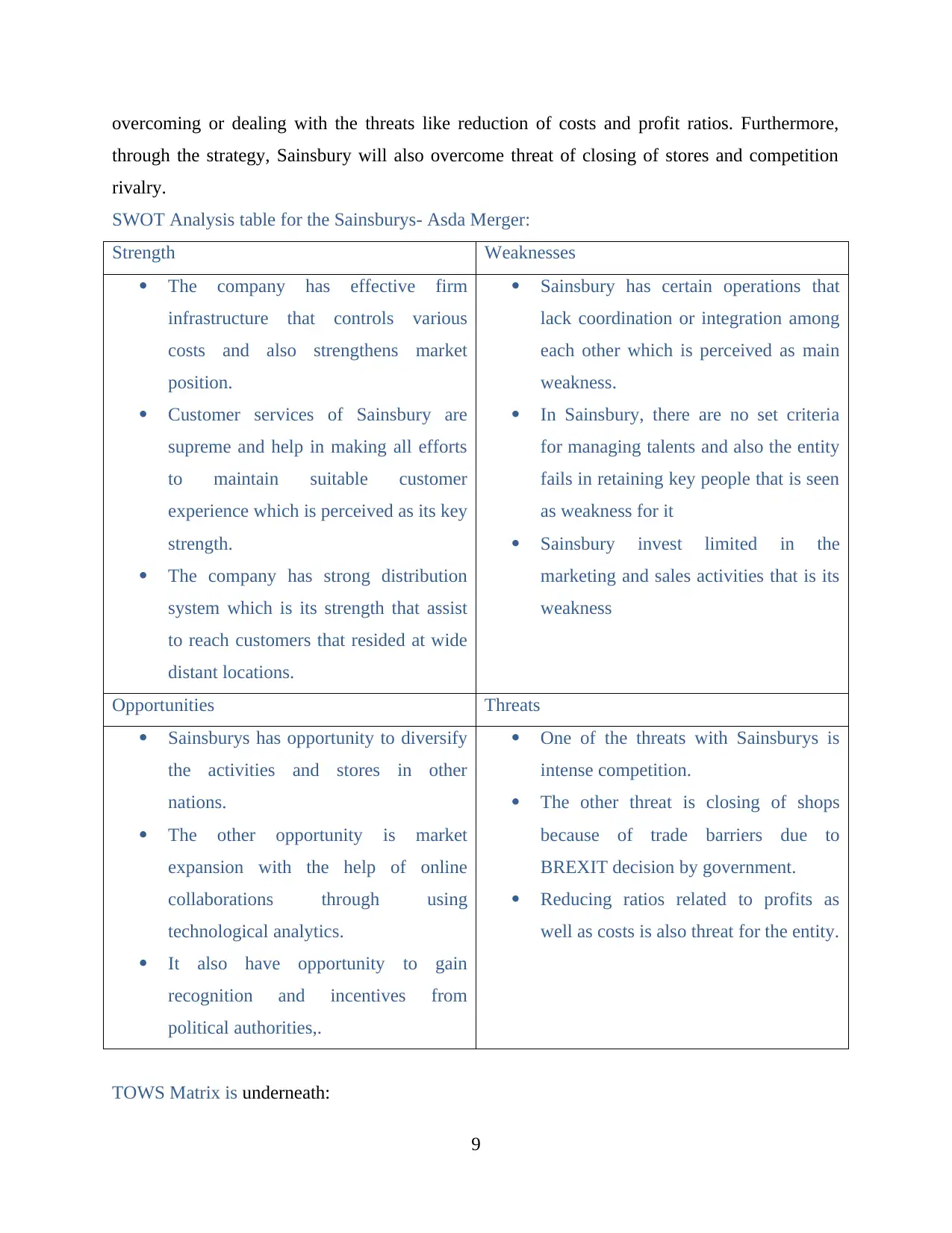
overcoming or dealing with the threats like reduction of costs and profit ratios. Furthermore,
through the strategy, Sainsbury will also overcome threat of closing of stores and competition
rivalry.
SWOT Analysis table for the Sainsburys- Asda Merger:
Strength Weaknesses
The company has effective firm
infrastructure that controls various
costs and also strengthens market
position.
Customer services of Sainsbury are
supreme and help in making all efforts
to maintain suitable customer
experience which is perceived as its key
strength.
The company has strong distribution
system which is its strength that assist
to reach customers that resided at wide
distant locations.
Sainsbury has certain operations that
lack coordination or integration among
each other which is perceived as main
weakness.
In Sainsbury, there are no set criteria
for managing talents and also the entity
fails in retaining key people that is seen
as weakness for it
Sainsbury invest limited in the
marketing and sales activities that is its
weakness
Opportunities Threats
Sainsburys has opportunity to diversify
the activities and stores in other
nations.
The other opportunity is market
expansion with the help of online
collaborations through using
technological analytics.
It also have opportunity to gain
recognition and incentives from
political authorities,.
One of the threats with Sainsburys is
intense competition.
The other threat is closing of shops
because of trade barriers due to
BREXIT decision by government.
Reducing ratios related to profits as
well as costs is also threat for the entity.
TOWS Matrix is underneath:
9
through the strategy, Sainsbury will also overcome threat of closing of stores and competition
rivalry.
SWOT Analysis table for the Sainsburys- Asda Merger:
Strength Weaknesses
The company has effective firm
infrastructure that controls various
costs and also strengthens market
position.
Customer services of Sainsbury are
supreme and help in making all efforts
to maintain suitable customer
experience which is perceived as its key
strength.
The company has strong distribution
system which is its strength that assist
to reach customers that resided at wide
distant locations.
Sainsbury has certain operations that
lack coordination or integration among
each other which is perceived as main
weakness.
In Sainsbury, there are no set criteria
for managing talents and also the entity
fails in retaining key people that is seen
as weakness for it
Sainsbury invest limited in the
marketing and sales activities that is its
weakness
Opportunities Threats
Sainsburys has opportunity to diversify
the activities and stores in other
nations.
The other opportunity is market
expansion with the help of online
collaborations through using
technological analytics.
It also have opportunity to gain
recognition and incentives from
political authorities,.
One of the threats with Sainsburys is
intense competition.
The other threat is closing of shops
because of trade barriers due to
BREXIT decision by government.
Reducing ratios related to profits as
well as costs is also threat for the entity.
TOWS Matrix is underneath:
9
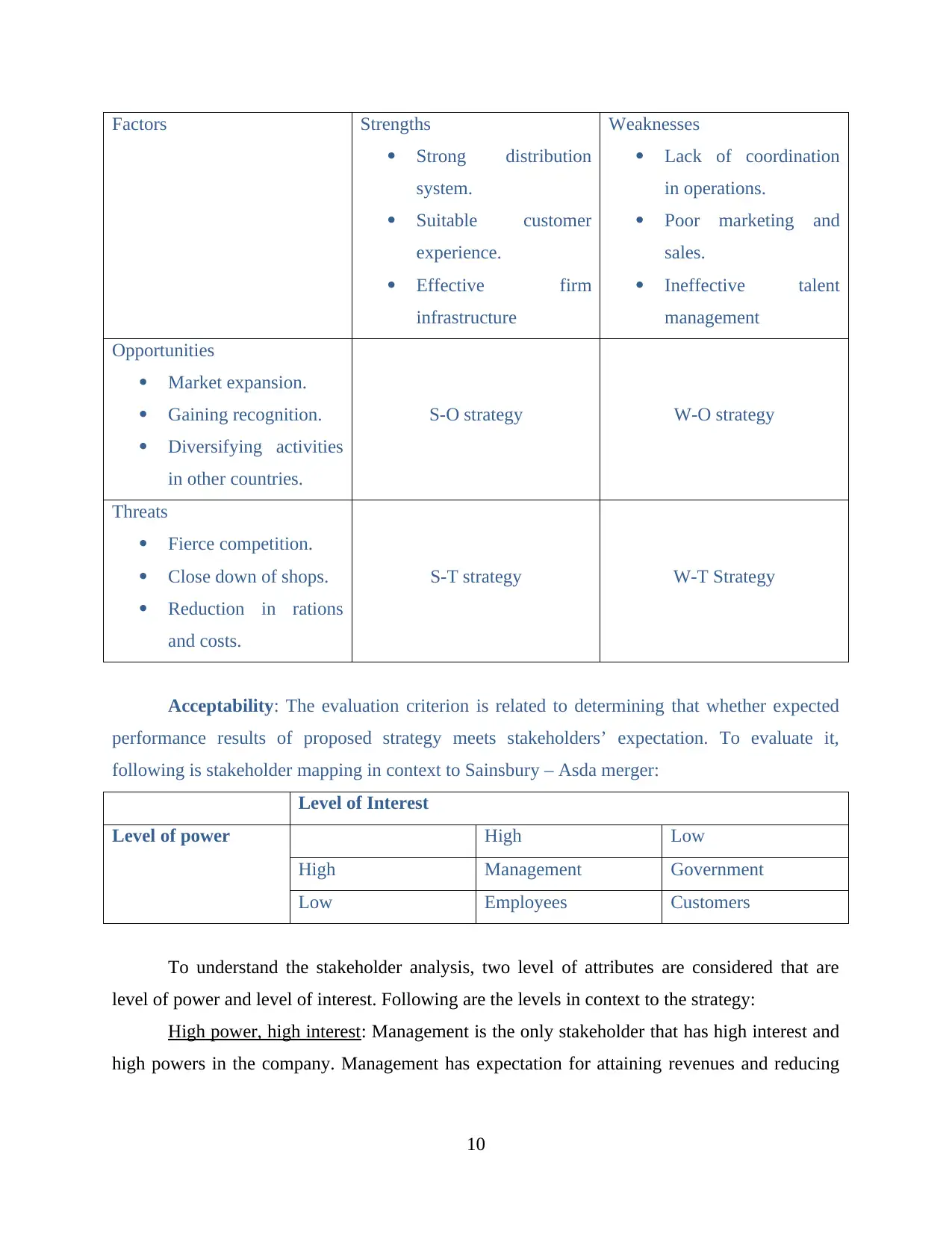
Factors Strengths
Strong distribution
system.
Suitable customer
experience.
Effective firm
infrastructure
Weaknesses
Lack of coordination
in operations.
Poor marketing and
sales.
Ineffective talent
management
Opportunities
Market expansion.
Gaining recognition.
Diversifying activities
in other countries.
S-O strategy W-O strategy
Threats
Fierce competition.
Close down of shops.
Reduction in rations
and costs.
S-T strategy W-T Strategy
Acceptability: The evaluation criterion is related to determining that whether expected
performance results of proposed strategy meets stakeholders’ expectation. To evaluate it,
following is stakeholder mapping in context to Sainsbury – Asda merger:
Level of Interest
Level of power High Low
High Management Government
Low Employees Customers
To understand the stakeholder analysis, two level of attributes are considered that are
level of power and level of interest. Following are the levels in context to the strategy:
High power, high interest: Management is the only stakeholder that has high interest and
high powers in the company. Management has expectation for attaining revenues and reducing
10
Strong distribution
system.
Suitable customer
experience.
Effective firm
infrastructure
Weaknesses
Lack of coordination
in operations.
Poor marketing and
sales.
Ineffective talent
management
Opportunities
Market expansion.
Gaining recognition.
Diversifying activities
in other countries.
S-O strategy W-O strategy
Threats
Fierce competition.
Close down of shops.
Reduction in rations
and costs.
S-T strategy W-T Strategy
Acceptability: The evaluation criterion is related to determining that whether expected
performance results of proposed strategy meets stakeholders’ expectation. To evaluate it,
following is stakeholder mapping in context to Sainsbury – Asda merger:
Level of Interest
Level of power High Low
High Management Government
Low Employees Customers
To understand the stakeholder analysis, two level of attributes are considered that are
level of power and level of interest. Following are the levels in context to the strategy:
High power, high interest: Management is the only stakeholder that has high interest and
high powers in the company. Management has expectation for attaining revenues and reducing
10
⊘ This is a preview!⊘
Do you want full access?
Subscribe today to unlock all pages.

Trusted by 1+ million students worldwide
1 out of 17
Related Documents
Your All-in-One AI-Powered Toolkit for Academic Success.
+13062052269
info@desklib.com
Available 24*7 on WhatsApp / Email
![[object Object]](/_next/static/media/star-bottom.7253800d.svg)
Unlock your academic potential
Copyright © 2020–2025 A2Z Services. All Rights Reserved. Developed and managed by ZUCOL.



